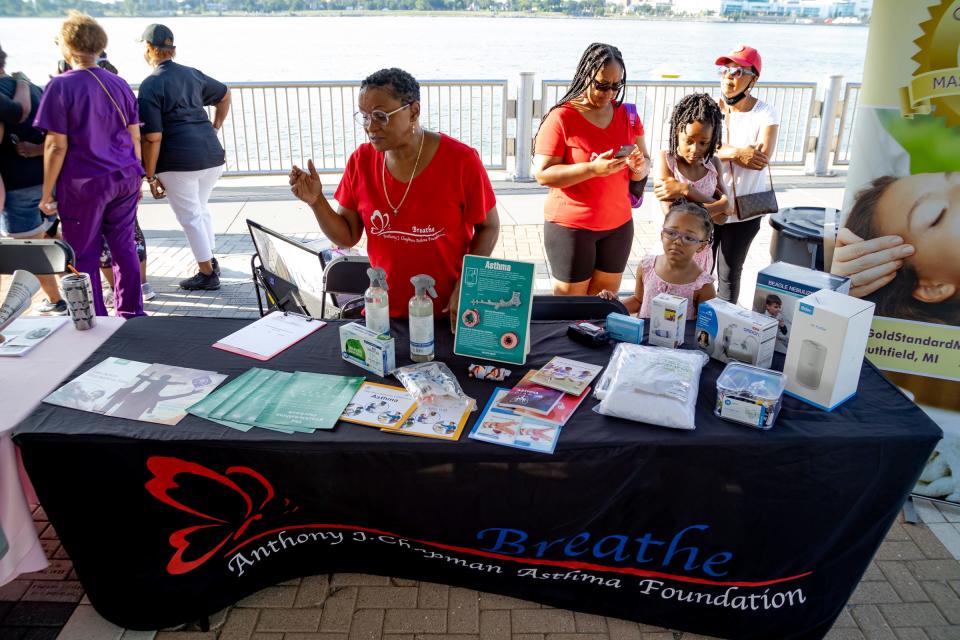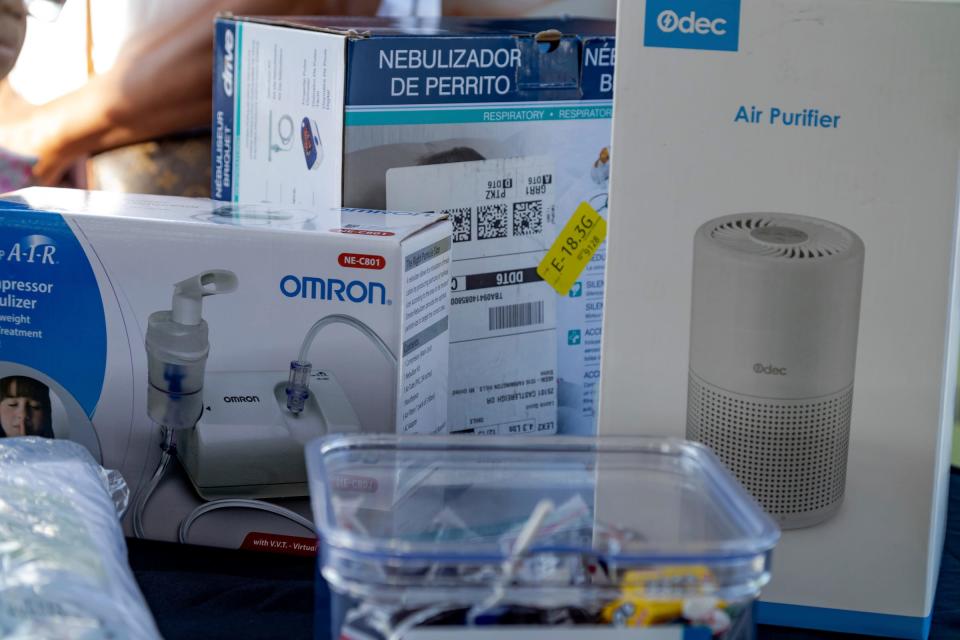Kids struggle to get effective asthma treatments in hotspots of Detroit, Wayne County

For nearly all his life, Anthony J. Chapman struggled to breathe.
His asthma only seemed to worsen as he grew older, said his mother, Laonis Quinn. He often missed class because of asthma symptoms.
In 2007, at 23, Chapman died after an asthma attack. More than a decade later, Quinn has started a foundation in his memory to help other families find the resources to help overcome what her son could not. It has become her passion in life.
"It's devastating for me," she said. "I know we just have to keep working. These things shouldn't happen."
Quinn isn't working alone. A number of organizations and individuals are trying to fill the gaps in the city's safety net for children suffering from asthma, particularly in and around schools.
With growing concern over climate change's health impacts on children and rising cases of asthma in children, community members and parents say children face significant barriers in getting effective treatment for asthma in Detroit.
But sorting through those resources and coordinating care is still a challenge for parents and caregivers.

Childhood asthma rates in Detroit are higher than the rest of the state, a disparity that did not exist in 2014, according to the Michigan Department of Health and Human Services. The rate of asthma in children in Detroit grew to 14.6% from 11.3% between 2014 and 2017, according to the state's most recent data. Statewide, 8.4% of children have asthma. The disease disproportionately affects Black Detroiters, the data shows.
Air quality in Detroit — specifically in areas with higher poverty rates — has also raised concerns over persistent asthma among children.
"Kids spend a good portion of their day either going to and from school, or in the school building," said Dr. Toby Lewis, a pediatric pulmonologist with the University of Michigan. "What can we do for these kids who have asthma to make sure that they're breathing the cleanest possible air?"
Asthma's reach in Detroit
Lewis' research revolves around public health conditions for children with asthma. And Detroit and Wayne County are hot spots for asthma in Michigan, she said.
Detroit children have higher asthma hospitalization rates compared with adults in the city and children statewide, according to state data.
Researchers have found that air pollution can worsen asthma symptoms and even trigger attacks.
And asthma's reach bleeds into many areas of life, Lewis said, including school.
"Asthma is, I believe, the most common medical reason why kids are missing school," she said.

Detroit's school district struggles with chronic absenteeism, when students miss 10% or more of the school year. More than half of Detroit's students were considered chronically absent in November, according to district data. Students miss school for a number of reasons, health included.
Dr. Elliott Attisha, a pediatrician and school health consultant, said early intervention matters because missed school days add up fast.
"Asthma can really interfere with the learning environment; it can impact concentration of the student," he said. "We know that the more days you miss school, the more that's going to impact your learning."
Intervention in and out of school
Danielle McDowell's three children struggle to breathe. The Melvindale mother's 13-year-old son keeps his inhaler in his backpack, approved by the school. But her 9-year-old's inhaler remains in a school office during the day because the boy has not received an asthma diagnosis yet, she said. A doctor gave him an inhaler, but not a prescription.

In one instance, her youngest struggled to breathe in the school office, but school officials had to call her before administering the inhaler. McDowell felt that her son struggled to breathe for longer than he should have had to, she said, with precious time wasted.
"It was like they really didn't take it seriously," she said.
Michigan law allows children to carry inhalers around school and self-administer the medication if they have a prescription or doctor's note on file. But administration can be more complicated for younger children, and experts say many children and adults don't know how to properly use an inhaler.
Education is a big part of Quinn's organization, called Breathe Anthony J. Chapman Foundation. She's a nurse and a certified asthma educator.
"I have found a lot of parents, kids, if you ask them if they know how to use their inhaler, most of the time it's wrong," she said.
So Quinn will instruct families on the proper way to use an inhaler, and gives out spacers, a tool that attaches to an inhaler to make receiving the medication easier.

In school, Attisha said it's important for children to have asthma action plans on file. These plans include what kind of medications students require regularly, what they require when their symptoms flare up and what they require when symptoms are severe.
"The important piece is coordinating that and making sure that every child has the ability to have medication at school, and and that way we're going to be able to keep our kids in school," Attisha said.
"In many cases a child ... might have a flare-up and if they have an inhaler at school, they can address the issue right there and then with their inhaler; if they don't have that inhaler then they end up going home and they may end up in the ER or the hospital because their asthma continues to stay out of control."
A school nurse is usually tapped to coordinate those plans. But not every school in Michigan has a nurse. Detroit Public Schools Community District did not respond to questions about how many schools have nurses or how many asthmatic students have asthma action plans on file.

But before an action plan, a diagnosis needs to come first. And getting the transportation and insurance resources to get a diagnosis are major hurdles for some Detroit parents, Lewis said.
But some schools have a solution to that problem, too.
"If patients can't get to the health care provider, bring the health care provider to the patient," she said.
At River Rouge High School, for example, Beaumont operates a health center for students and community members. Colleen Bryant, a pediatric nurse practitioner at the teen health center, said the center can conduct tests to help diagnose asthma and measure severity.
She'll help children determine what triggers their asthma, like allergens or smoke, and come up with proactive solutions to avoid those triggers.
"The big thing is just managing their asthma," she said. "So what do they need to do to keep themselves healthy?"
But even with so many initiatives to improve asthma management around the city, Lewis said the cause likely needs more resources and more attention to the systemic issues triggering asthma, like environmental racism and disproportionate levels of air quality in minority neighborhoods.
"There are kids who die of asthma every year and that's a tragedy," she said. "It's not one thing that leads to those deaths. ... It's a system, there's holes in the system."
Resources for Detroit parents
Many organizations outside schools are also working to treat asthma.
Resources for parents and caregivers include:
Getasthmahelp.org: A website built by the Asthma Initiative of Michigan, which includes data and resource lists.
The Asthma and Allergy Foundation of America, Michigan chapter: This organization employs certified asthma educators, providing education to those who need it.
Kids Health Connections: This nonprofit in Detroit connects children eligible for Medicaid with community health workers.
To maximize treatment in school and out of school, experts recommend:
Parents and caregivers should work with their school, usually a school nurse or someone else in the front office, to have an asthma action plan on file.
Children need a prescription or doctor's note to keep their inhaler with them, which also involves coordination with the school.
Recognizing asthma triggers proactively is crucial, Laonis Laoins Quinn said, because asthma can turn severe very quickly.
Contact Lily Altavena: laltavena@freepress.com or follow her on Twitter @LilyAlta.
This article originally appeared on Detroit Free Press: Detroit kids struggle with high asthma rates: How parents can find help

